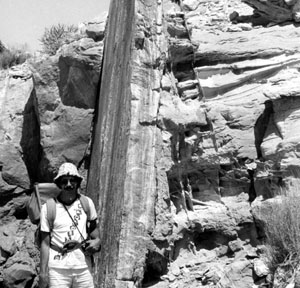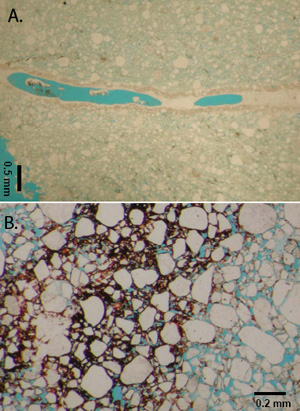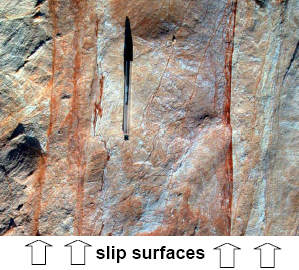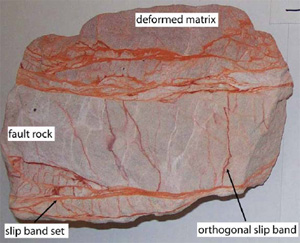| |||||||||||||||
|
|
|||||||||||||||
|
|
|||||||||||||||
| Slip Surfaces, Slip Bands, and Slickensides | |||||||||||||||
|
Slip surfaces refer to the smoothed, lineated, and grooved surfaces, with the linear marks called slickensides (Figure 1 and Figure 2). They are associated with frictional sliding and form either on the original wall rock or within the core.
In deformation band based faults, the slip surfaces normally develop on the boundary of the fault rock as shown in Figure 2. Since slip surfaces may have some opening along their lengths, they act as conduit to fluid flow. As a result of diagenetic processes, these openings are commonly filled by precipitations (Figure 3). Figure 4 shows red-stained slip surfaces in the outcrop view as evidence of paleofluid flow activities. The filled slip surfaces are then called slip bands (Ahmadov, 2006; Ahmadov et al, 2007) due to their tabular appearance. After being partially or fully filled, their ability to carry fluid decreases. For detailed discussion of the permeability of individual slip bands and upscaled permeability of this type of faults, please see the links at the bottom of this page. For example, Ahmadov (2006) documented the geometry of slip surface and slip bands within Aztec Sandstone at Valley of Fire State Park, Nevada. The slip surfaces and slip bands are the most continuous elements within the fault zones. They are nearly planar in map view, with lengths ranging from several centimeters to several tens of meters and widths ranging from 0.1 to 1 mm. Slip surfaces and bands form normally as single features, but in some cases individual slip bands may merge into a zone (Figure 5). The density of the slip bands varies dramatically along a single fault, but can exceed 10 per 10 cm in both fault-parallel and fault-normal directions for well-developed zones.
| |||||||||||||||
| Reference: |
|||||||||||||||
| Ahmadov, R., 2006 Ahmadov, R., Aydin, A., Karimi-Fard, M., Durlofsky, L.J., 2007 Aydin, A., Johnson, A.M., 1978 |
|||||||||||||||
|
Readme | About Us | Acknowledgement | How to Cite | Terms of Use | Ⓒ Rock Fracture Knowledgebase |
|||||||||||||||




